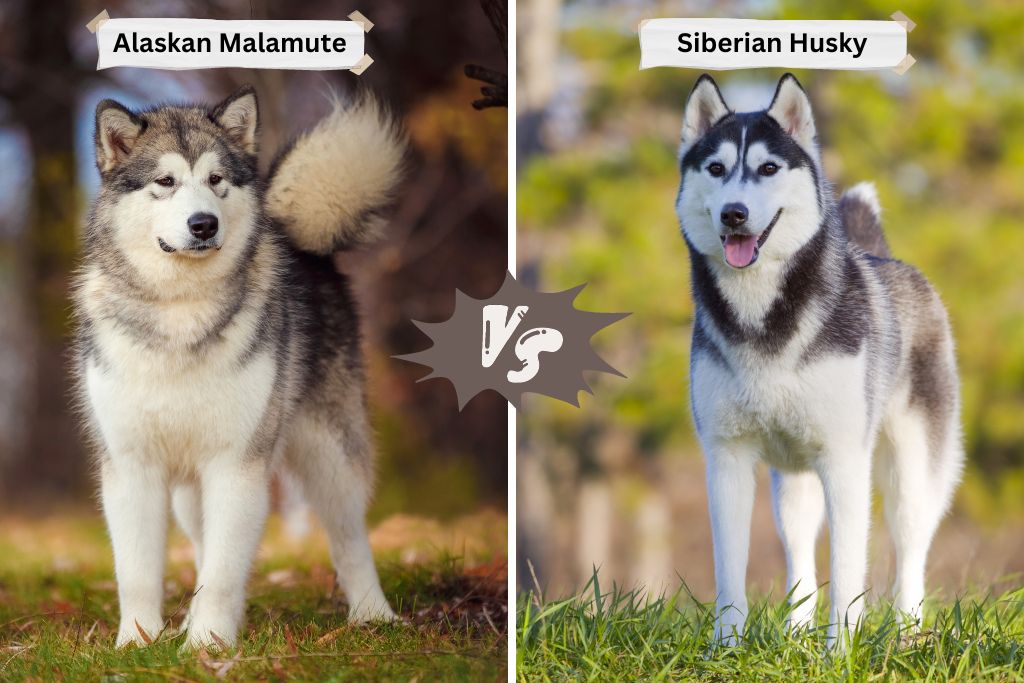
In the expansive realm of dog breeds, the Alaskan Malamute and the Siberian Husky are two majestic and powerful breeds that have captured the hearts of many.
Both these awe-inspiring canines with roots in chilly terrains and a rich history of assisting humans in arctic endeavors are often mistaken for one another.
Yet, beneath the surface lies a world of distinction between them. From their early origins to their unique physical attributes and temperaments, the Malamute and Husky have stories and characteristics that set them apart while highlighting their incredible adaptability and resilience.
Whether you’re an enthusiast, a potential dog owner, or just curious about these breeds, this exploration into the world of the Alaskan Malamute and Siberian Husky will offer a comprehensive view of their key differences and enchanting similarities, with comparison tables to provide an at-a-glance way of understanding.
Historical Background: Malamute vs. Husky
Both the Malamute and Husky have stories deeply rooted in human survival amidst the planet’s most challenging terrains. These histories showcase their crucial roles in ancient communities and emphasize their remarkable endurance and adaptability.
Alaskan Malamute: The Arctic's Loyal Worker
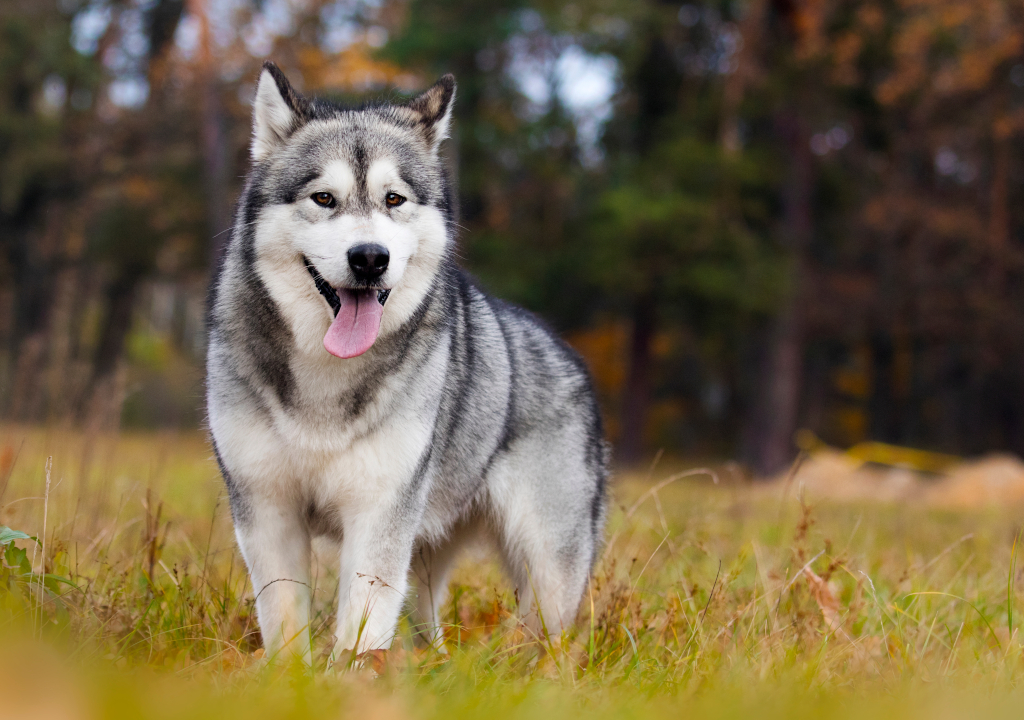
Emerging from the chilly expanses of Alaska, the Malamute’s lineage dates back over 4,000 years, making it one of the oldest Arctic sled dogs. The breed gets its name from the Mahlemut tribe, inhabitants of Alaska’s Norton Sound area.
For these indigenous people, Malamutes were indispensable, aiding in hunting seals and polar bears, as well as transporting hefty sleds filled with essential goods. In the unforgiving Arctic, the Malamute’s power and resilience were paramount.
Siberian Husky: The Chukchi's Enduring Spirit
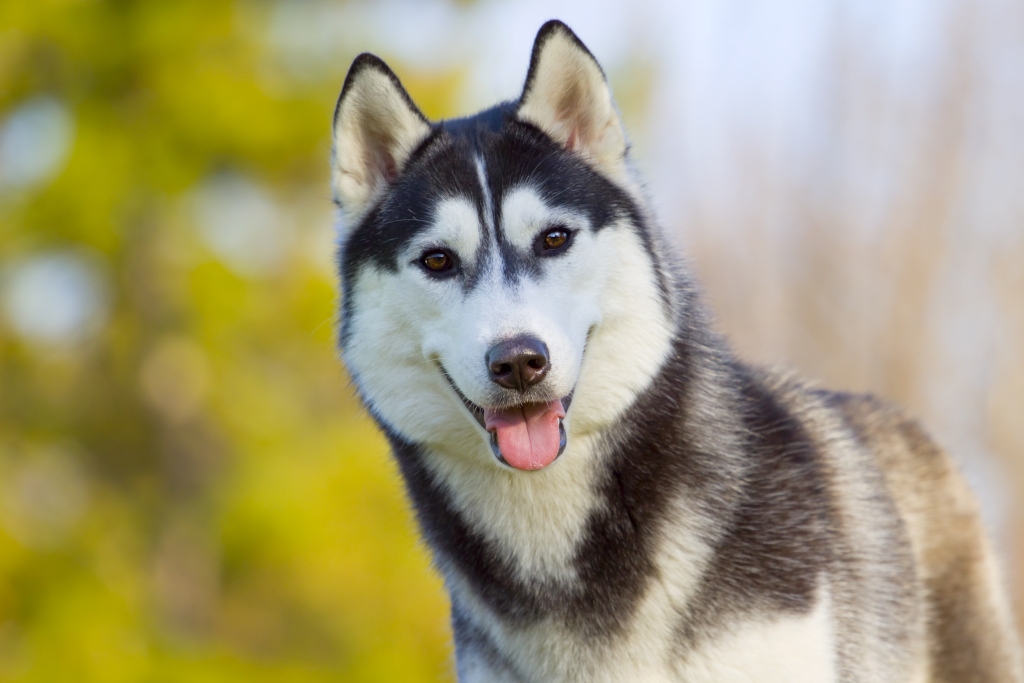
On the opposite side, the Siberian Husky’s tale begins in the icy stretches of Siberia with the Chukchi people. This ancient breed served a dual purpose: as a transportation solution across vast snowy expanses and as warm, affectionate companions during the biting Siberian nights.
Bred for endurance and efficiency, the Huskies were pivotal for the Chukchi, allowing them to travel vast distances without needing vast food reserves. This breed’s tenacity was further highlighted during the early 20th century in the Serum Run to Nome, wherein they were instrumental in transporting life-saving medication.
| Aspect | Alaskan Malamute | Siberian Husky |
|---|---|---|
| Origin | Alaska | Siberia |
| Historical Role | Hunting & heavy sled pulling | Long-distance transportation & warmth |
| Associated Tribe | Mahlemut | Chukchi |
| Age of Breed | Over 4,000 years | Over 9,500 years |
| Prominent Characteristics | Strength & resilience | Endurance & efficiency |
| Notable Event | Essential to Mahlemut survival | Serum Run to Nome |
| Year Recognized by the American Kennel Club | 1935 | 1930 |
** Comparison Table: Alaskan Malamute vs. Siberian Husky - Historical Background
Note: Though sharing commonalities, these two breeds have distinct legacies that underline their vital roles in human survival. Both breeds, beyond their captivating appearances, embody a tale of partnership, resilience, and mutual reverence amidst nature's harshest conditions.
Physical Differences: Alaskan Malamute vs. Husky
At first glance, the Alaskan Malamute and Siberian Husky might appear similar, but several distinctive features set them apart upon closer inspection. From their size and build to coat color and facial features, each breed boasts a unique look that distinguishes them.
1. Size and Build
The Alaskan Malamute is noticeably larger and more robust than the Siberian Husky. Built for power and endurance, Malamutes have a muscular and sturdy frame that serves them well for their heavy-lifting roles in the Arctic.
Male Malamutes typically weigh about 85 pounds and stand around 25 inches tall at the shoulder. Females are slightly smaller, weighing about 75 pounds and standing 23 inches tall.
In contrast, the Siberian Husky is a medium-sized dog breed. More agile and sleek in their build and bred for speed and efficiency, Huskies have a lighter frame that allows them to cover long distances quickly.
A male Husky generally weighs between 45 and 60 pounds and stands around 21 to 23.5 inches tall at the shoulder. Female Huskies weigh between 35 to 50 pounds and stand approximately 20 to 22 inches tall.
2. Coat and Color
Both breeds have a dense double coat that protects them from the harsh Arctic cold and comes in various colors, including black and white, gray and white, red and white, agouti and white, and sable and white.
The key difference lies in their coat patterns and markings.
Malamutes have a distinct coat pattern. Their underbelly is fully white, extending from chest to tail tip, with a topcoat in color mentioned.
Huskies, however, exhibit a wider array of full coat patterns.
3. Facial Features
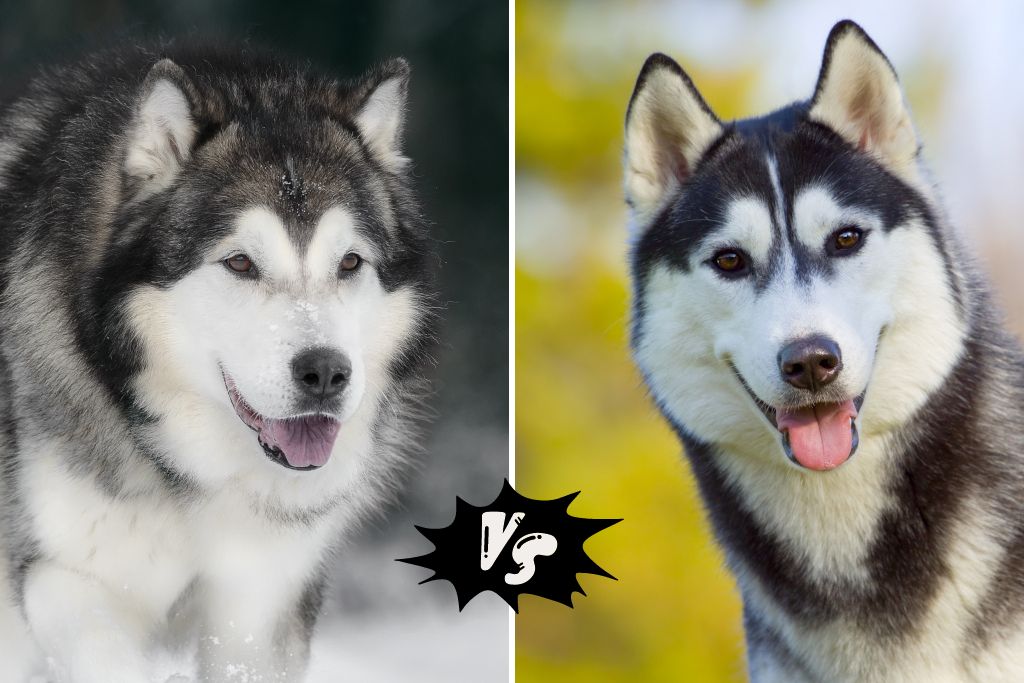
While both dog breeds appear to have perpetually raised eyebrows, their facial markings differ.
Most Siberian Huskies have a stripe, often an extension of muzzle color, usually bright white, that goes up the middle of their foreheads.
In contrast, Alaskan Malamutes have forehead color, frequently black, that extends down towards their white snouts, forming a kind of arrow.
Eye color also sets them apart. Siberian Huskies are likely to have various shades of eye color, including blue and brown. Some may even have heterochromia, in which each eye has a different color, for instance, one brown and one blue eye.
Malamutes, on the other hand, predominantly have brown eyes.
4. Tail Shape
Another distinguishing feature is their tails. While both breeds have fluffy tails, Malamutes have a curled, bushier tail carried over their back, whereas Huskies have a tail shaped like a brush pointing downward.
| Aspect | Alaskan Malamute | Siberian Husky |
|---|---|---|
| Size & Build | Larger, muscular & robust | Sleeker, agile & lighter |
| Male Weight | ~85 lbs | 45-60 lbs |
| Male Height | ~25 inches | 21-23.5 inches |
| Female Weight | ~75 lbs | 35-50 lbs |
| Female Height | ~23 inches | 20-22 inches |
| Coat Colors | Gray & White, Agouti & White, Black & White, Red & White, Sable & White, Seal & White, Silver & White, Blue & White, White | Agouti & White, Black & White, Gray & White, Red & White, Sable & White, Brown & White, Black Tan & White, White, Black |
| Coat Pattern | White underbelly, topcoat with color | Varying full coat patterns |
| Facial Mask | Arrow-shaped | Stripe up the middle of forehead |
| Eye Color | Brown | Blue, brown, heterochromia |
| Ears | Medium-sized, triangular, erect | Medium-sized, triangular, erect |
| Muzzle | Broad & powerful | Proportionate |
| Tail Shape | Curled | Brush-shaped |
** Comparison Table: Alaskan Malamute vs. Siberian Husky - Physical Appearance
Temperament and Personality Differences
The temperament and behavior of both the Alaskan Malamute and Siberian Husky are shaped by their unique histories and roles. Their distinct personalities make them beloved pets, but they have specific characteristics that potential owners should be aware of.
Malamute Temperament
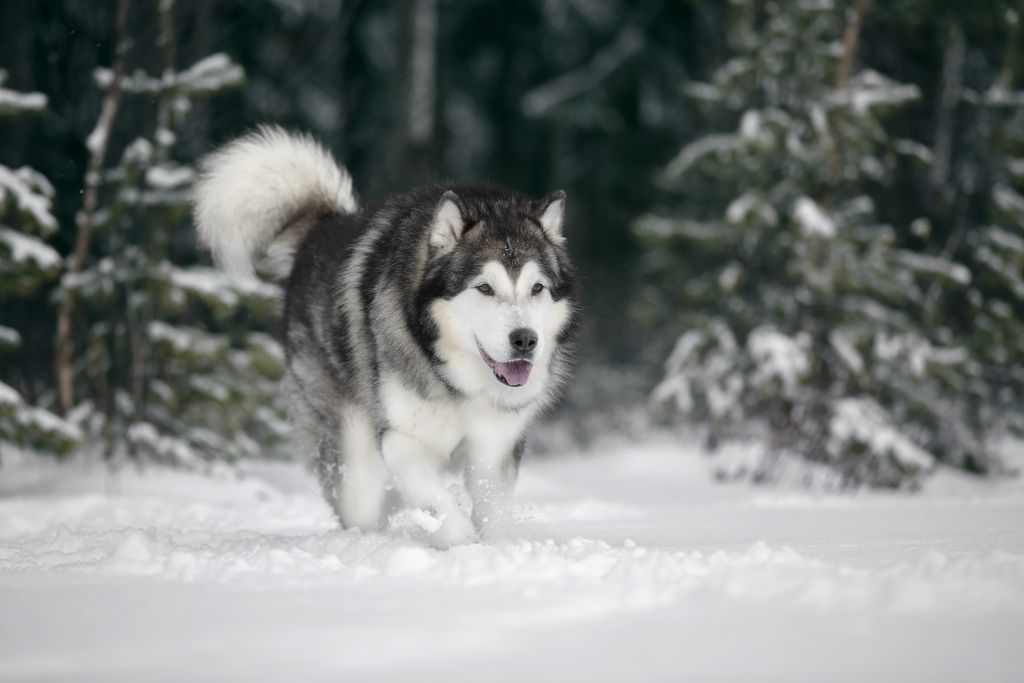
The Alaskan Malamute is known for being friendly yet independent. Affectionate and sociable with their families, Malamutes tend to be more aloof with strangers.
Mals are also known for their independent streak, which can sometimes be mistaken for stubbornness. Their history as working dogs in the Arctic, where they needed to make decisions without human guidance, has instilled in them a certain level of autonomy.
This independence can be a challenge for first-time dog owners, but with proper training and socialization, Malamutes can be very obedient and well-mannered.
Additionally, Malamutes are less tolerant of other animals, particularly other dogs, when compared to Huskies. And notably, they are also skilled escape artists, so secure fencing and vigilance are essential.
You May Also Like: Different Types Of Dog Fencing
Husky Temperament
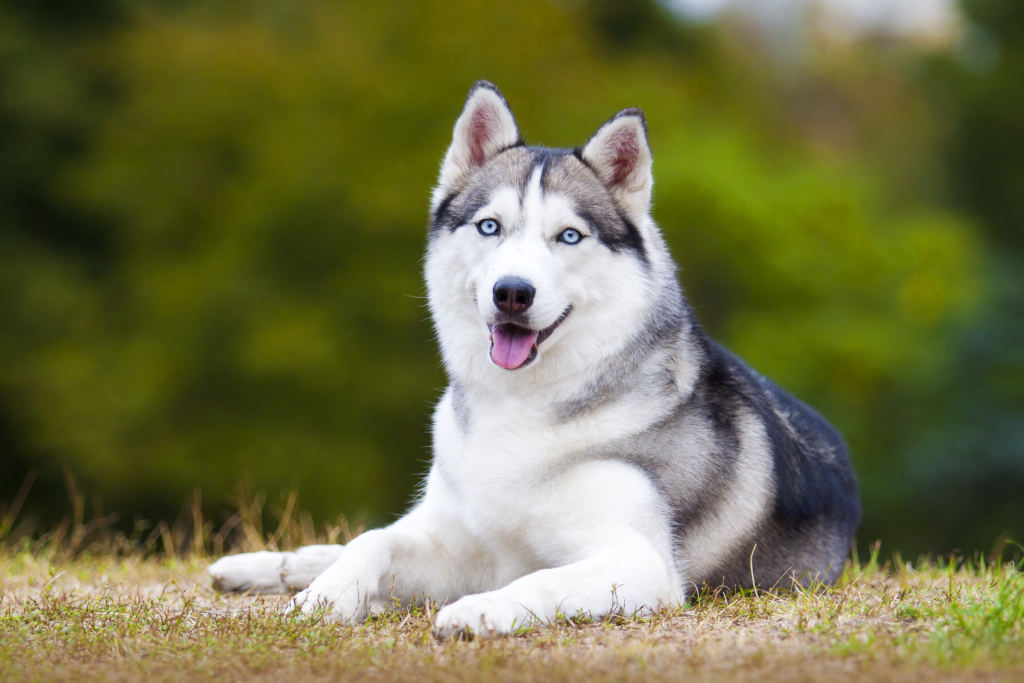
The Siberian Husky, on the other hand, is celebrated for its playful and sociable demeanor. Outgoing, friendly, and generally good with other dogs and children, Huskies desire to be part of the pack. This sociability makes them more amiable than Malamutes.
They’re also more vocal than Malamutes, often communicating through howls, barks, and “talking” sounds. Their history as community dogs with the Chukchi people has shaped their friendly and approachable behavior.
However, their intelligence and playfulness can make them mischievous, requiring consistent training. Like Malamutes, Huskies are also Houdini Hounds, skilled at overcoming barriers, so it’s essential for owners to have secure fencing and to keep a watchful eye on them.
You May Also Like: Top-Rated Dog GPS Collar: Keep Tabs On Your Dog!
| Aspect | Alaskan Malamute | Siberian Husky |
|---|---|---|
| Personality | Friendly yet independent | Playful and sociable |
| Affectionate | Yes | Yes |
| Social with other dogs | Less tolerant of other dogs | Typically very good with other dogs |
| Good with children | Yes | Yes |
| Independence | Independent, may seem stubborn | Less independent, eager to please |
| Aloof with strangers | More aloof | Less aloof |
| Tolerance for other animals | Lower tolerance for other animals | Higher tolerance for other animals |
| Vocality | Less vocal | More vocal |
| Intelligence | Intelligent, autonomous thinker | Intelligent, playful thinker |
| Training Difficulty | Can be challenging due to independence | Easier due to sociability, but requires consistency |
| Escape Artist | Yes, skilled escape artist | Yes, skilled escape artist |
** Comparison Table: Alaskan Malamute vs. Siberian Husky - Temperament and Behavior
Training
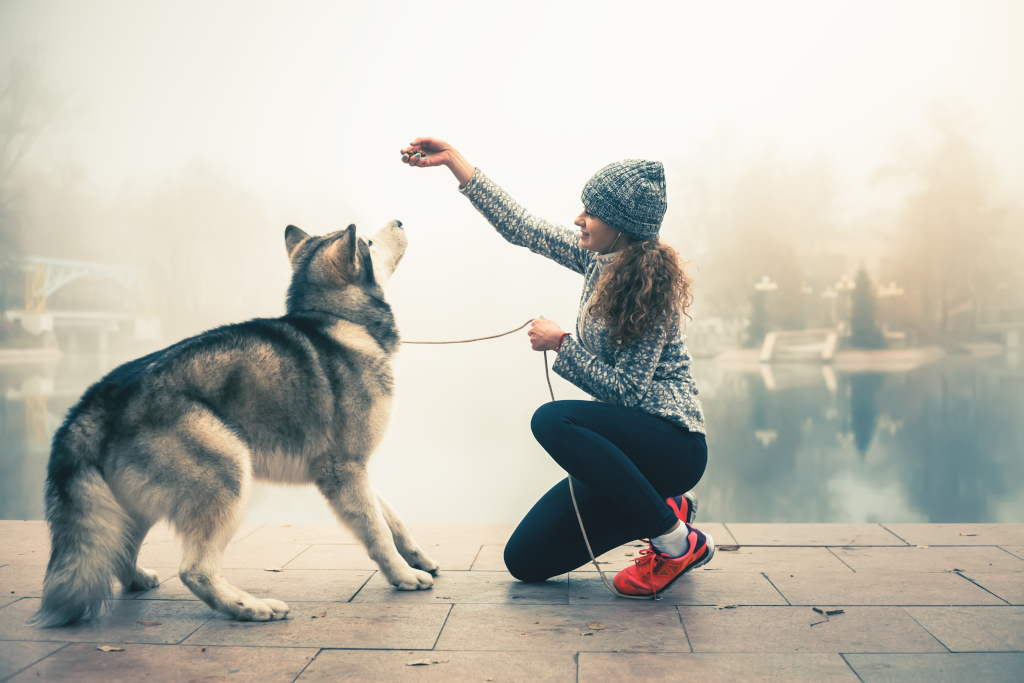
Both Alaskan Malamutes and Siberian Huskies can be a challenge to train due to their intelligence and independent nature. However, with the right approach, it’s possible to train both breeds effectively.
Training Alaskan Malamutes
Malamutes are known for their independence and stubbornness, which can make training a bit challenging. They’re intelligent and will quickly learn commands, but they may choose not to obey if they don’t see a reason to do so.
It’s important to establish yourself as the pack leader and be consistent with training. Malamutes respond well to positive reinforcement, so ensure to use treats and praise as rewards. They also have a strong prey drive, so socializing them with other animals from a young age is essential.
You May Also Like: 7 Popular Types Of Dog Training Methods To Train Your Dog
Training Siberian Huskies
Huskies are also intelligent and independent, but they’re more sociable and less stubborn than Malamutes.
They enjoy the company of people and other dogs, which can be a valuable tool in training. Like Malamutes, they respond well to positive reinforcement.
It’s crucial to start training and socializing Huskies early to prevent undesirable behaviors later on. They can be vocal and tend to howl, so teaching them a “quiet” command is helpful.
You May Also Like: Tips To Stop Your Dog From Barking
Tips for Potential Owners
For both breeds, being patient, consistent, and firm during training is essential. Both Malamutes and Huskies benefit from early socialization, obedience training, and regular mental stimulation.
Keep training sessions short and enjoyable, and always end on a positive note. As pack animals, they need a confident leader who sets boundaries and enforces them.
| Aspect | Alaskan Malamute | Siberian Husky |
|---|---|---|
| Ease of Training | Moderate, may be stubborn and independent | Moderate, independent but sociable |
** Comparison Table: Alaskan Malamute vs. Siberian Husky - Training
Energy Levels and Exercise Needs: Alaskan Malamute vs. Husky
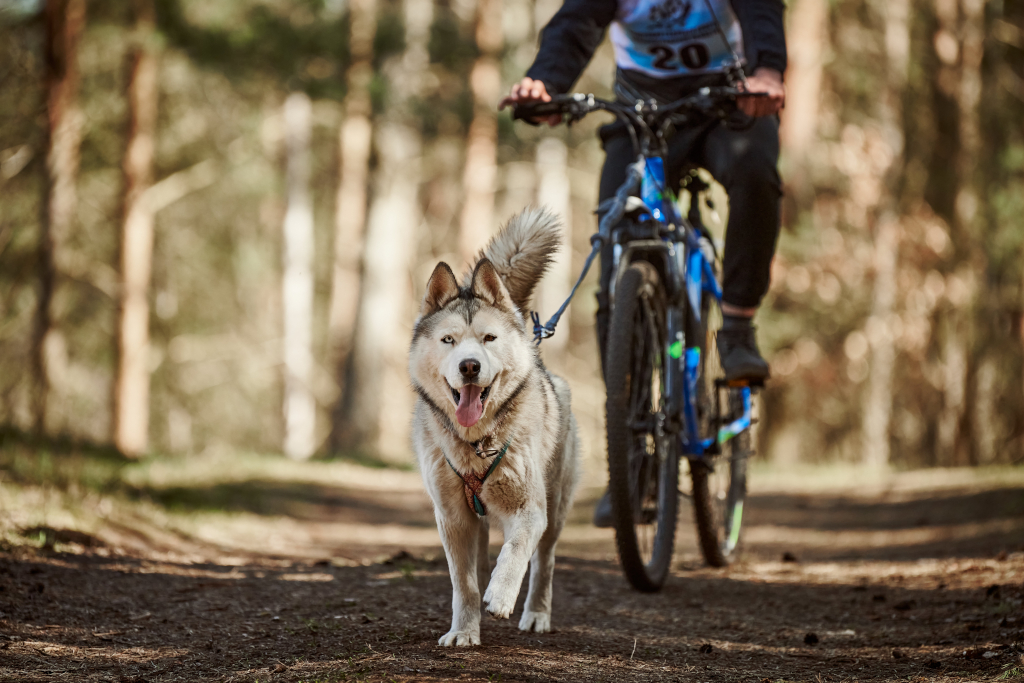
The Alaskan Malamute and Siberian Husky are active breeds requiring significant daily exercise to stay healthy and happy. However, due to their different historical roles, their energy levels differ.
Originally bred as an arctic sled dog to pull heavy loads over short distances, the Alaskan Malamute requires about 90 minutes of exercise each day, and suitable activities include snowshoeing and sled dog racing.
Mals are also intelligent dogs, so they also need mental stimulation. Puzzle toys and advanced obedience training can help keep their minds active and engaged.
Siberian Huskies, on the other hand, have a seemingly endless supply of energy. Well. They were bred to pull sleds over long distances, although only light loads. As such, they need about two hours of exercise daily to keep their energy in check.
Due to their intelligence, Huskies also benefit from mental challenges. Puzzle toys and advanced obedience training can help keep them mentally stimulated.
Without sufficient mental and physical stimulation, both Huskies and Malamutes may become restless and display undesirable behavior.
You May Also Like: How to Go Snowshoeing With Dogs?
| Aspect | Alaskan Malamute | Siberian Husky |
|---|---|---|
| Energy Level | High | Very high |
| Exercise Requirement | Approx. 90 minutes daily | Approx. 2 hours daily |
| Boredom if Inactive | Likely to become restless and display undesirable behavior | Likely to become restless and display undesirable behavior |
** Comparison Table: Alaskan Malamute vs. Siberian Husky - Energy Levels and Exercise Needs
Lifespan and Health
Both the Malamute and Husky have specific health concerns and lifespan expectations. Taking proper care of their health through regular check-ups, a balanced diet, and proper exercise can contribute to a healthier and longer life.
1. Lifespan
The Malamute has an average lifespan of 10-14 years, while the Husky typically lives a bit longer, between 12-14 years.
2. Common Health Concerns
Generally speaking, the Siberian Husky is healthier than the Alaskan Malamute and has fewer health problems.
Health issues Huskies are prone to include hip dysplasia, a condition affecting the hip joint. They are also susceptible to eye problems such as cataracts, which cause cloudiness in the lens of the eye, and Progressive Retinal Atrophy (PRA), a degenerative eye disorder that can eventually lead to blindness.
Malamutes, like Huskies, are prone to hip dysplasia. Additionally, they may face health issues such as chondrodysplasia, a genetic disorder that affects bone growth and can result in dwarfism.
Hypothyroidism, a condition where the body doesn’t produce enough thyroid hormone, is another concern in Malamutes. They are also susceptible to Polyneuropathy, a neurological disorder that affects the peripheral nerves.
You May Also Like: Solutions for Dog Insomnia
| Aspect | Alaskan Malamute | Siberian Husky |
|---|---|---|
| Lifespan | 10-14 years | 12-14 years |
| General Health | More health concerns | Healthier with fewer health problems |
| Common Health Issues | Hip dysplasia, chondrodysplasia, hypothyroidism, Polyneuropathy | Hip dysplasia, cataracts, Progressive Retinal Atrophy |
** Comparison Table: Alaskan Malamute vs. Siberian Husky - Health and Lifespan
Nutritional Needs
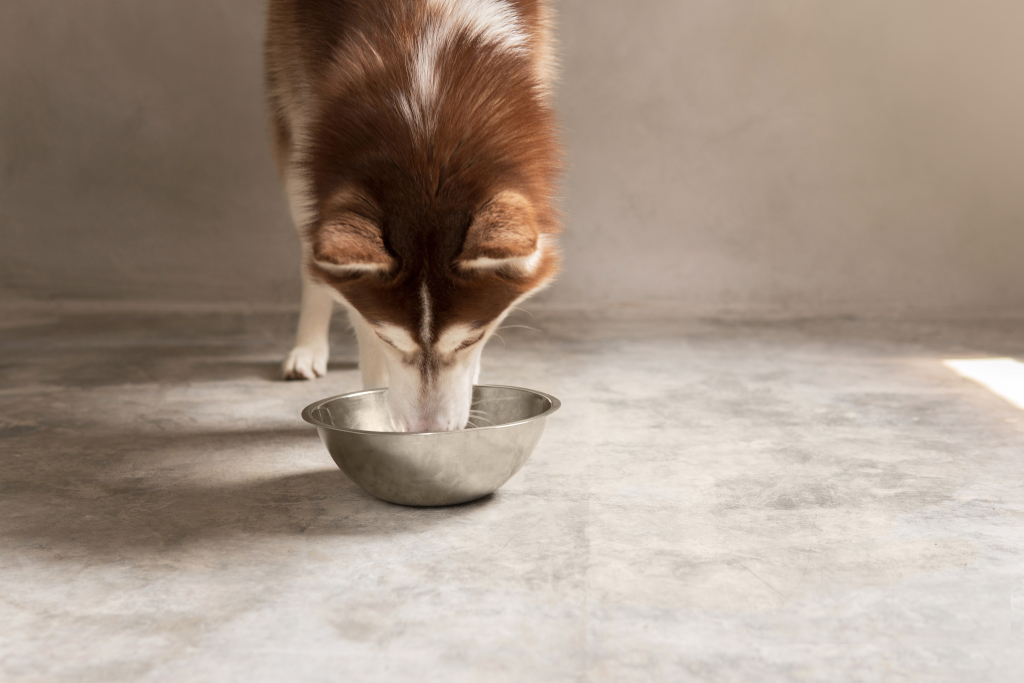
Malamutes are larger dogs whose caloric needs generally reflect their size and activity levels. On average, an adult Malamute may need 4 cups of high-quality kibble per day, divided into two meals.
Smaller than Malamutes and having an efficient metabolism, Huskies only need around 3 cups of high-quality kibble per day, divided into two meals.
It’s essential to keep in mind that factors such as activity levels, age, and overall health can impact their nutritional requirements. For instance, active dogs may require more food, while less active or older dogs might need less.
If unsure, always consult with your veterinarian to determine the appropriate amount of food for your specific dog, and be sure to monitor their weight regularly to ensure they are maintaining a healthy body condition.
You May Also Like: What To Do If My Dog Won’t Eat?
| Aspect | Alaskan Malamute | Siberian Husky |
|---|---|---|
| Average Daily Kibble Intake | ~4 cups | ~3 cups |
| Meal Frequency | Twice a day | Twice a day |
** Comparison Table: Alaskan Malamute vs. Siberian Husky - Nutritional Needs
Grooming Needs
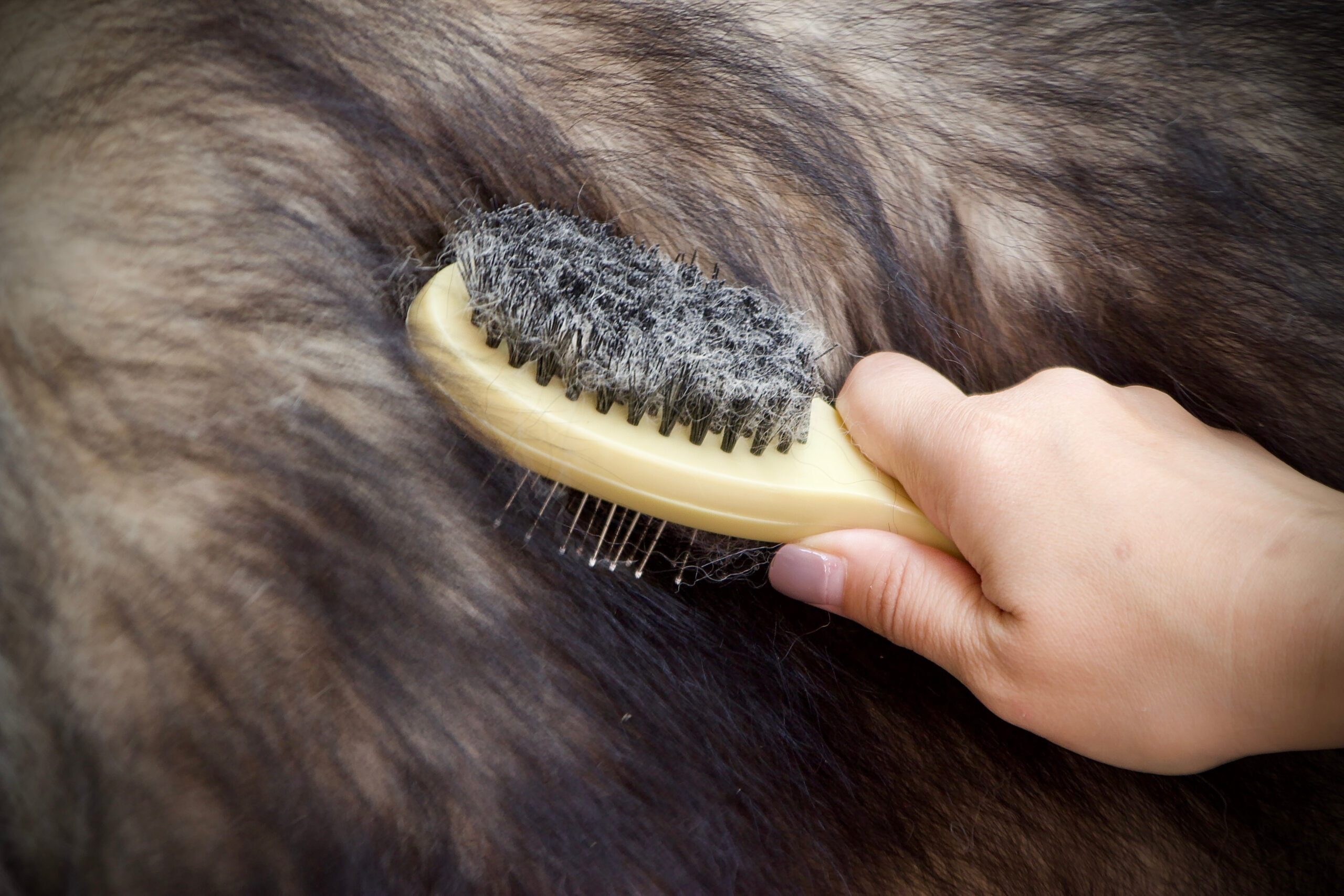
While both the Alaskan Malamute and the Siberian Husky have a double coat, their grooming requirements differ.
Malamutes shed their undercoat twice a year, usually in the spring and fall. During these periods, daily brushing is essential to manage loose hair.
Outside of these shedding seasons, Malamutes should be groomed at least two to three times a week to prevent matting and maintain the health and appearance of their coat.
Huskies also shed their undercoat twice a year, and similarly, daily brushing is crucial during these times.
However, Huskies generally require less grooming outside of the shedding seasons, with weekly brushing usually being sufficient as they are self-cleaning dogs.
You May Also Like: Best Dog Nail Grinders: Trim Your Dog’s Nails Safely
| Aspect | Alaskan Malamute | Siberian Husky |
|---|---|---|
| Shedding Seasons | Twice a year (Spring & Fall) | Twice a year (Spring & Fall) |
| Brushing Frequency | 2-3 times a week, daily during shedding seasons | Once a week, daily during shedding seasons |
** Comparison Table: Alaskan Malamute vs. Siberian Husky - Grooming Needs
Puppy Prices
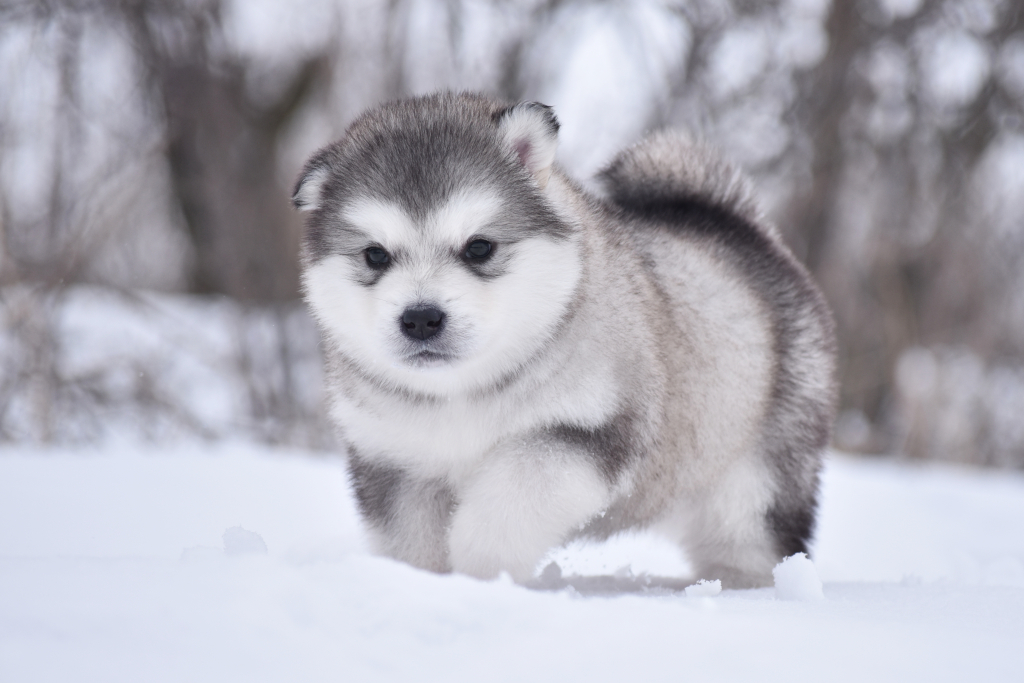
When considering adding a new furry member to your family, it’s important to consider the financial commitment, and the initial cost of a puppy can be a significant factor. Both the Husky and Malamute are popular breeds, but there is a difference in their average price.
The Siberian Husky generally costs less than the Alaskan Malamute. Prices for a Husky puppy typically range between $1,000 and $2,500. Of course, factors like the breeder’s reputation, location, and the puppy’s lineage can influence the price.
The Alaskan Malamute is a larger and more robust breed than the Husky, and this is reflected in its higher price. Malamute puppies usually cost between $1,500 and $3,000. Again, the price can vary based on factors like the breeder’s reputation, location, and the puppy’s lineage.
| Aspect | Alaskan Malamute | Siberian Husky |
|---|---|---|
| Average Price Range | $1,500 and $3,000 | $1,000 and $2,500 |
** Comparison Table: Alaskan Malamute vs. Siberian Husky - Puppy Prices
Which Breed is Better? Husky or Malamute?
Deciding between an Alaskan Malamute and a Siberian Husky can be challenging as both breeds are unique and have their own strengths. However, it ultimately depends on your specific needs, lifestyle, and the environment you can provide.
If you’re looking for a playful and sociable dog with a slightly lower maintenance grooming schedule, Huskies could be the right fit. One thing, though, is that they are known for being vocal. Their mournful howls might not please the neighbors!
Malamutes, on the other hand, are more independent and less vocal than Huskies. They also require less exercise than Huskies, about an hour and a half per day, but need more frequent grooming. They can be more aloof with strangers and have a lower tolerance for other animals.
In both cases, it’s crucial to provide a secure yard to prevent them from escaping and be prepared for regular exercise and mental stimulation.
Owning either breed requires a high level of commitment and understanding of their specific needs. Both breeds thrive in active households that can provide them with the attention, training, and care they need to thrive.
In conclusion, there is no one-size-fits-all answer. It is up to you to assess your living conditions, energy levels, and commitment to training and grooming to decide which dog breed is a better fit for your home.
Remember, a well-cared-for and well-trained dog, regardless of the breed, will bring joy, companionship, and a unique personality into your life.
Frequently Asked Questions About Husky vs. Malamute
Q1. Are malamutes calmer than Huskies?
Generally, Alaskan Malamutes are known to be more laid-back and less hyper than Siberian Huskies. While Huskies are often described as being more energetic, mischievous, and agile, Malamutes are considered to be more mellow and reserved. That said, it’s important to note that every dog is unique, and there can be considerable variation in personality within each breed.
Q2. Are malamutes as difficult as Huskies?
Both Malamutes and Huskies have their own challenges. Both breeds are intelligent and independent, which can sometimes make them stubborn and more difficult to train. However, they are not inherently “difficult” dogs; with proper training, socialization, and care, both breeds can be loving and loyal companions. It’s important to be consistent and patient when training and handling either breed.
Q3. Which breed is closest to a wolf?
Of the two, the Alaskan Malamute is generally considered to be more similar to the wolf in terms of its size, build, and facial features. Malamutes are larger, have a broader head, and are more heavy-set than Huskies, giving them an appearance that is more reminiscent of a wolf.
You May Also Like:

